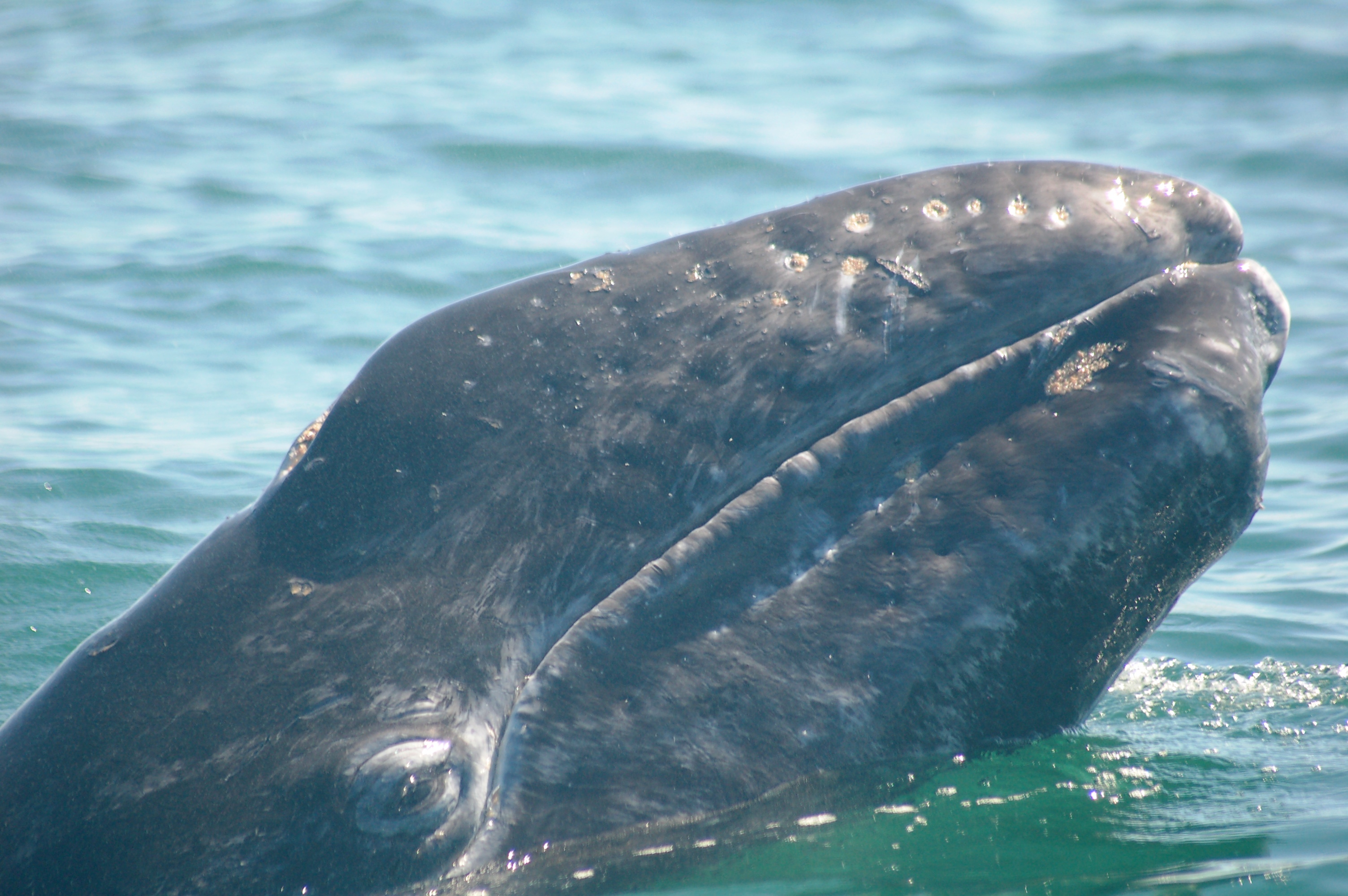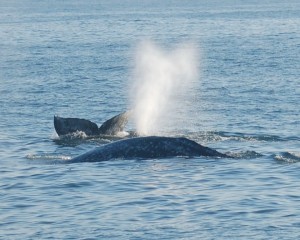
Photo credit: Bobbie Hedges
Imagine doing a major road trip for 5,000 to 7,000 miles.
Now imagine making that trip 11 months pregnant.
Now imagine making the return trip of 5,000 to 7,000 miles just three months after arriving and giving birth.
Now imagine doing these two major road trips every year of your life until the day you die.
Are you picturing this? If you are able to come even remotely close to grasping what this would be like, then you are one step closer to understanding the life of the Pacific gray whale.
Every year Southern Californians are graced by the presence of these marvelous mammals as they make their way along the coast of North America from the Bering and Chukchi Seas (ocean areas next to and north of Alaska) to the Baja California peninsula and then back again. The gray whale’s annual journey is one of the longest mammal migrations in the world.
But this iron man worthy round trip is just one of many amazing and unique characteristics of the gray whale. For starters, instead of a having a dorsal (back) fin, the gray whale has a dorsal ridge, which consists of six to 14 dorsal knuckles extending down the back with a large pronounced knuckle leading the range in the typical place a dorsal fin would be.
The gray whale is also gray of course, but this slate gray background is accented by natural white markings plus great patches of white barnacles and orange lice giving gray whales a much more artsy look than their name conveys. The barnacles and two of the three types of cyamids (whale lice) are species specific, meaning they are only found on the gray whale.
Eschrichtius robustus, the scientific name for the gray whale, is the only living member of the family Eschrichtiidae. While the gray whale is a baleen whale and filters food just like the blue whale and other whales belonging to the scientific suborder Mysticeti, the gray whale is classified in a league of its own.
Gray whales are the only baleen whales to rely on the ocean floor as a main source of meals. During the summer feeding season up north, gray whales eat 24 hours a day in preparation for their lengthy journey. This entails diving down and flipping or angling to be on the right side (right as in right handed) to suck in ocean sediment containing bottom-dwelling amphipods (tiny shrimp-like creatures) while swimming slowly along.
But in order to bulk up, gray whales are open to other calorie options and have also been observed eating “locally abundant swarming species such as cumaceans, mysids, shrimp, krill, mobile amphipods, and shoals of sardines and anchovy,” according to the Encyclopedia of Marine Mammals.
As adults, gray whales average 40 to 45 feet in length and weigh approximately 40 tons. But their waistlines expand and contract in direct relation to the annual migration. During the summer from May through October, gray whales work hard to fatten up, especially pregnant females who gain an additional 25 to 30% more weight than other gray whales, plus the weight of the baby on the way. This extra fat allows the gray whales to survive the next six to seven months without much food, as they fast during most of the traveling and winter season.

Photo credit: Bobbie Hedges
In the fall, according to the Encyclopedia of Marine Mammals, “whales start the southward migration with females in late pregnancy going first, followed by adults and immature females, then immature males.” And now we are getting to one of the purposes for this annual road trip—bringing forth the next generation.
Once gray whales reach the lagoons of Baja California, here in the shallower more protected areas they breed and give birth. But some gray whales mate during the road trip and in some cases pregnant females give birth before reaching the destination. Just like the babies born on the way to the hospital, they call the shots! When calves are born they average 12 to 14 feet in length and weigh 1,000 to 1,500 pounds.
Of course males are ready and able to mate every year, while females typically operate on a two-year reproductive cycle since carrying a calf to term takes 12 to 13 months. According to the encyclopedia, this means that during any given year “at most only half the reproductive females are available annually for mating.”
When it’s time to get it on gray whales forego the bar fights and instead of males physically battling other males for the opportunity to mate with females, they practice seventies style free love. “Gray whales appear to have a promiscuous mating system, where both sexes may copulate with several partners during the breeding season,” as told by the Encyclopedia of Marine Mammals.
This free love strategy, minus the drugs, is known as sperm competition: a type of natural selection process where a male’s sperm achieves dominance by washing out another’s or a male manages to mate with the same female more times than other males. Either way his sperm wins. So the sperm do all the fighting while the gray whales do all the loving.
While other gray whales are busy free loving, new moms are busy raising their new calves and preparing them for the long journey back. Moms nurse with milk that contains up to 53% fat allowing gray whale calves to gain 25 to 75 pounds per day. Calves need to bulk up quickly to increase their chances of survival in more dangerous areas of the open ocean where their main ocean predator lurks…the killer whale.
Of course, humans are also a threat to gray whales. There are actually two distinct Pacific gray whale populations and during whaling times both were decimated. Our gray whales belong to the Eastern Pacific group and have recovered quite well since gray whaling was banned with an estimated current population of 20,000 to 22,000 whales. However, the Western Pacific gray whales, a separate group of whales migrating along Asia’s coast, have never recovered and are critically endangered with an estimated 120 whales left.
Now the biggest threat all gray whales face is the loss of habitat from human generated pollution and development. Our gray whales seem to be doing pretty good despite these challenges and are also protected by the Marine Mammal Protection Act as they traverse along the U.S. coast. But for the Western Pacific gray whales, unless drastic action is taken, their population could be lost forever.
Since it’s that time of year when the gray whales are passing our coast on their annual road trip, make sure you take time to go whale watching and get a glimpse of these magnificent mammals. The Cabrillo Marine Aquarium and the American Cetacean Society’s Los Angeles Chapter partner to train volunteers as whale watch naturalists to make sure your whale watching trip is fun and educational. And in an attempt at full disclosure, I must admit that I am one of those volunteer naturalists and used my trusty whale watch fact card for many of the statistics cited in this column.
I hope to see you sometime on the Voyager, which departs daily from the Redondo Pier. Together we will team up to spot the distinct heart-shaped blows of the Pacific gray whale as it takes time to breathe along the open ocean road.
[…] For more fun facts about gray whales, check out my post Gray Whales: on the road again. […]